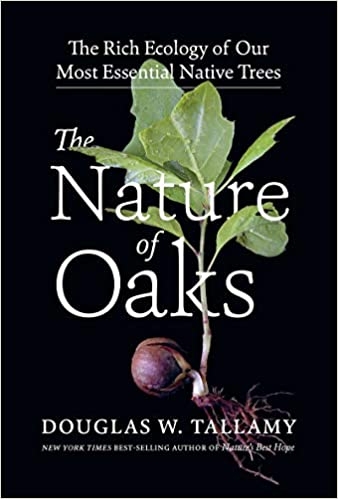
- ISBN-10 : 1643260448
Every book has a lesson to learn; a message to deliver. Douglas Tallamy's lessons are profound and insightful helping to reveal the natural world in greater clarity and cohesiveness.
In THE NATURE OF OAKS, a universe comes to life in an oak tree in his garden in Pennsylvania. One acorn, planted and placed as a seedling managed to grow and create a world full of rich relationships, interdependencies, and possibilities in his backyard. It is a world Tallamy was able to observe over time that was contained, isolated and simplified and held his focus and interest. Enough bits and pieces are revealed and shared by Tallamy to direct our understanding of the complex and intricate weaving of our natural world. From one oak tree canopy top to its root tips, his white oak tree is just one small microcosm of a more profound system just small enough to comprehend but complex enough to teach.
The world of this oak tree is explored with a monthly calendar of events highlighting the tree's life and some of the characters that share it. Many insights into the workings of trees, birds, insects, nutritional cycles, and interconnected lifecycles are described. References supporting the information and fuel for further studies are included. The argument to really see a universe in a grain of soil justifies the writing and reading of this book. So, here is just a brief taste of the many wonders revealed.
It starts in October and November. Maybe, it is a little quieter time in a busy year? Yet, maybe, this is when it starts. The infinite possibilities when the acorns are ready and full of promise for another generation. Dispersed by birds and other critters and cached for winter food stores, the acorn begins the tale. It is nutrition and shelter for the acorn moth larvae feeding on the acorn weevil in a developing acorn. And in turn it is a vessel for those acorn weevil larvae that survive and plummet to the ground in a race to hide and pupate in the soil before being fodder for a hungry bird. So many paths are possible for an acorn besides germination and the beginning of a new oak tree.
In December and through the winter, it is noticeable that the mature oak maintains its leaves while other trees do not. Food for caterpillars with specialized mouth parts benefit. They can chew through the tough, dry and bitter leaves. Birds in the neighborhood that overwinter, can find caterpillars to eat and make it through difficult days. But also revealed are the many ways that caterpillars adapt by hiding or disguising themselves against predation or using the tree to provide winter protection.
And all the while, as winter seems to encourage sleep, life teams in the soil. Microorganisms, fungi, of many types and purposes provide for the upcoming seasons of growth and reproduction. Plants capture the sun and share the results but need nutrients to complete the process. The oak provides with a consistent source of leaves and debris. The oak receives the nutrients to grow and produce seed in turn.
So as March drama begins in earnest, winter breaks and spring blooms. A chorus of life specific to the oak tree sings. So many birds and insects have specific native hosts. The oak is a keystone host with 511 species of caterpillars to support while other tree species don't even come close. April and May bring bloom, bird migration and new life, hungry and eager to develop. June begins summer and the fulfilment of spring in a multitude of dances and dramas to find food or provide food, develop and reproduce including the oak tree and its developing acorn.
Then September comes around on our way to winter and a slowing and securing for another year. Migrations, maturing, dispersal, senescence, dormancy, with the completion of so many lifecycles. Because of its long life, extensive resources and endurance, Tallamy's white oak, is there to provide food and shelter creating a vibrant ecology of great depth and breadth. In a universe of many interwoven ecologies that can be observed, understood and respected, this white oak with its curious human, experience the lessons of living viewed on an approachable scale.
We are reminded how much life depends on the native plant population and safe human practices in our natural world. Life evolves slowly and together to balance the needs of all along for the ride. Leaf shape, color, mouthparts, behavior, plant specialization, timing, hairy vs non hairy, on and on and on can be seen in the many ways that life adapts and persists over time to accomplish birth, growth, reproduction and return of precious borrowed resources. We are part of that and intimately involved in it all. We are also pushing and tugging on the delicate threads that connect us and ultimately must sustain us. Do we understand this?
In the NATURE OF OAKS, Tallamy reveals his observations and discoveries to us. Scientifically based studies, statistics and observations document the observations and information presented. Photos are included as well. He points out the layers and interconnections and the interdependencies of the many living beings around this white oak tree. It is an opportunity for us to perceive the greater story told on a smaller scale. Life on this planet is one huge and complex totally connected organism with lots of working parts. We can see it working if we look. But like many things we take for granted, we don't notice it is there until there is a problem. One oak tree can make a difference and so can one human. One book can, too.